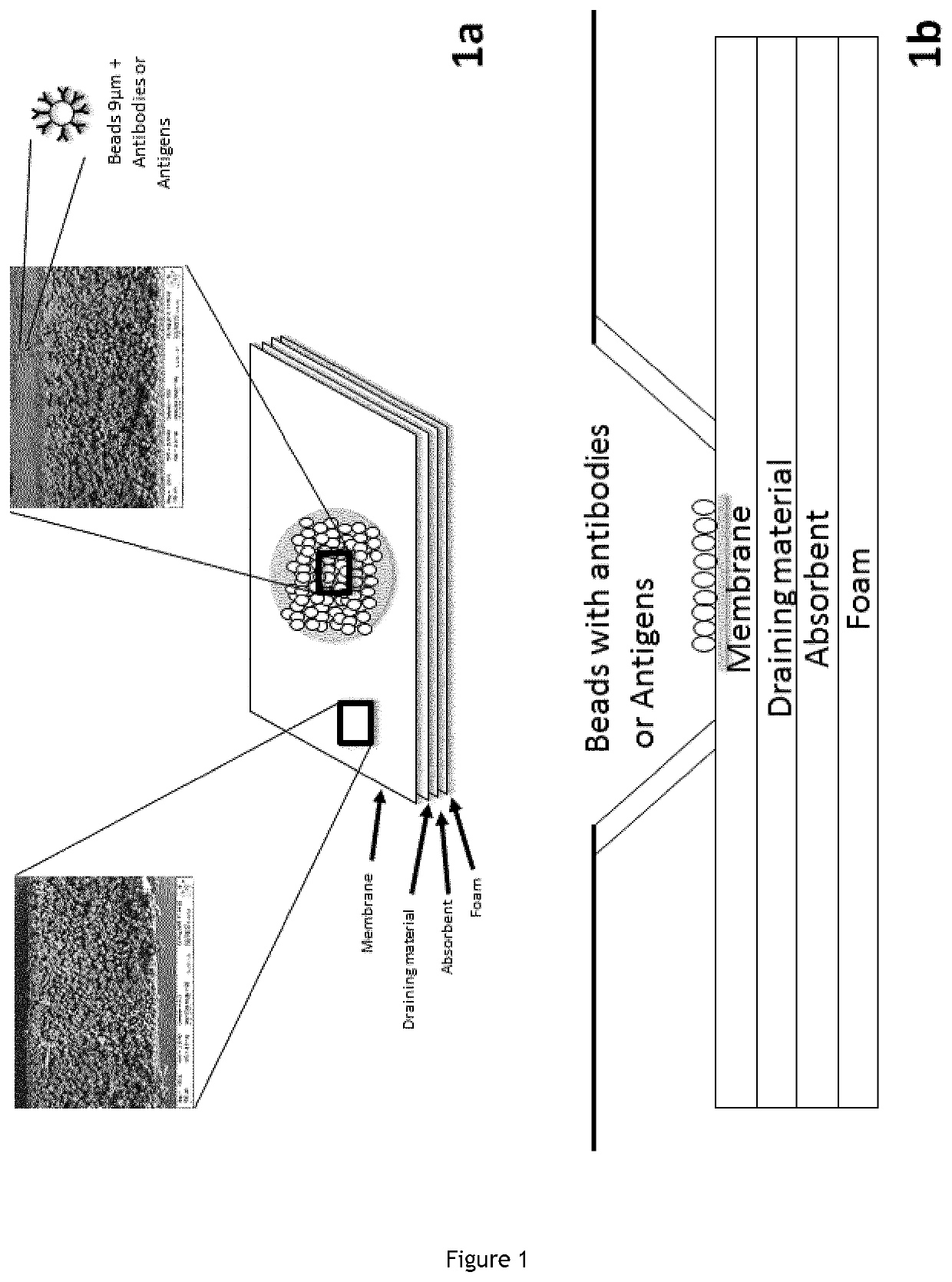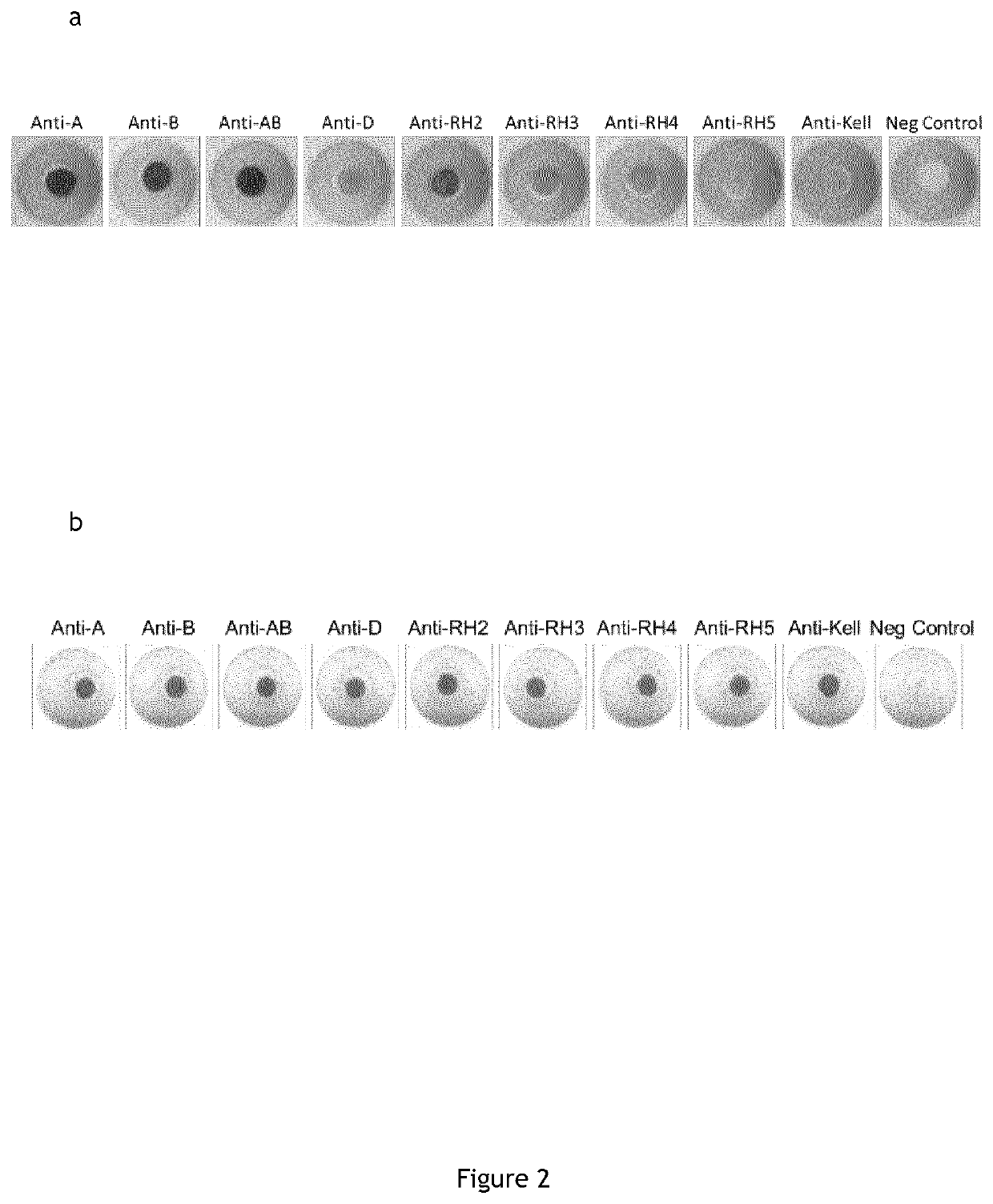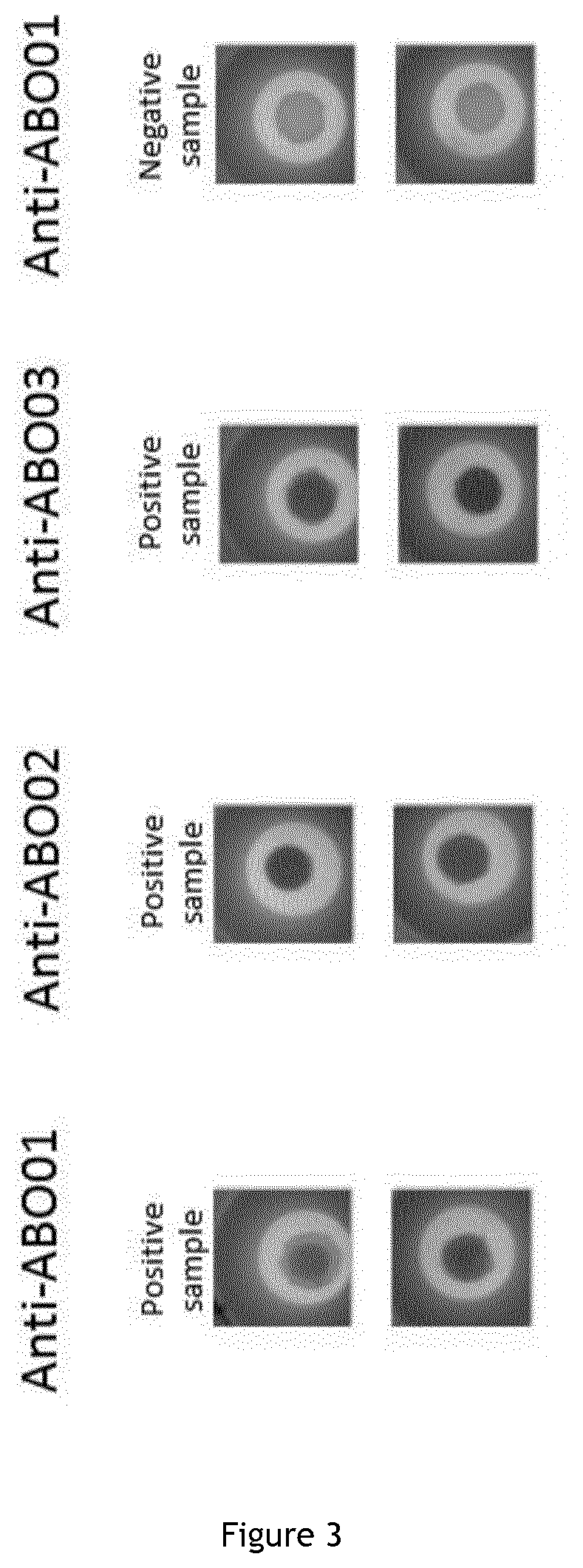In vitro diagnosis device comprising beads and uses thereof
a technology of in vitro diagnosis and beads, which is applied in the field of immunodeficiency diagnosis to achieve the effect of improving the sensitivity and specificity of detection and reducing the quantity of used analytes
- Summary
- Abstract
- Description
- Claims
- Application Information
AI Technical Summary
Benefits of technology
Problems solved by technology
Method used
Image
Examples
example 1
Cell Typing and Phenotyping in the In Vitro Device With Direct and Indirect Coupling of Anti-Red Blood Cells Antibodies on Beads Via Anti-Immunoglobulins IgM and IgG
1. Protocol for Preparing the In Vitro Device That Comprises on the Surface of the Reaction Area the Anti-Red Blood Cells Antibodies Directly Spotted on the Membrane
1.1.Materials for the Preparation of the In Vitro Device
[0317]Membrane “POREX” 0.6 mm hydrophobic with 9 to 12 μm porosity; Cotton;[0318]Cleanis;[0319]Hydrophilization buffer (1% triton, 1% Green dye, phosphate buffered saline).[0320]Wash Buffer (TLA composition);[0321]Dilution buffer (Chromasolcoombs);[0322]Antibodies (Anti-ABO01, Anti-ABO02, Anti-ABO03, Anti-RH1, Anti-RH2, Anti-RH3, Anti-RH4, Anti-RHS, Anti-KEL1, Negative Control).
1.2.Preparation Mode of the Reaction Medium
[0323]Deposit 1 μl of the hydrophilization solution in each well;[0324]Drying 16 hours at 37° C. and 10% humidity;[0325]Deposit 2 μl of antibody per well;[0326]Drying 72 hours at 37° C. a...
example 2
Coupling of Red Blood Cells Antibodies Via Affinity Proteins for Antibodies
1. Indirect Antibodies Coupling
[0349]On 1 ml of homogenized 4% latex beads (Thermo Fisher latex Aldehyde / Sulfate 9 μm 4% w / v), 5 or 2.5 μg of Protein AGL are dissolved in 3 ml PBS1× and are added. The solution is end over end mixed overnight to ensure coupling.
[0350]On 1 ml of centrifugated 4% beads (Thermo Fisher latex Aldehyde / Sulfate 9μm 4% w / v) coupled with protein AGL, 3 ml of 1× phosphate buffered saline are added and 1 ml of Anti-ABO01 antibody (91 13 D10 Diagast clone) or Anti-ABO02 antibody (96 21 A8 Diagast clone) or Anti-ABO03 (152D12 Diagast clone) are dissolved. The solution is end over end mixed overnight to ensure coupling.
[0351]The coupled beads are then centrifuged 5 min at 2500 g. Finally the bead pellet is resuspended in the conservation buffer (phosphate buffered saline supplemented with 0.5% bovine serum albumin and 0.25M saccharose) to get back the introduced bead solution weight.
2. Reac...
example 3
of Antibodies of Red Blood Cells on Beads Having Different Chemical Functional Groups on Their Surface and Different Size in Different Reactional Conditions
1. Chloromethyl Group
1.2. Antibodies Coupling
[0357]On 500 μl of homogenized chloromethyl beads (Thermo Fisher chloromethyl latex beads 4% w / v, 2.0 μm) 1.5 ml of phosphate buffer is added and the obtained solution is centrifuged at 3000 g for 20 min. The supernatant is discarded and the bead pellet is then resuspended with a mix of 950 μl of phosphate buffered saline and 50 μl of concentrated CPC51 or CP6D4 (Diagast AHG).The antibody bead solution is incubated overnight at room temperature on a tube rocker.
[0358]After AHG chemical coupling, the bead solution is centrifuged at 3000 g for 15 min and the supernatant is discarded. The beads are washed with 1.5 ml of phosphate buffered saline and the solution is centrifuged at 3000 g for 10 min. The supernatant is discarded and the excess active groups are blocked by adding 1 ml of 1 M...
PUM
| Property | Measurement | Unit |
|---|---|---|
| size | aaaaa | aaaaa |
| size | aaaaa | aaaaa |
| size | aaaaa | aaaaa |
Abstract
Description
Claims
Application Information
 Login to View More
Login to View More - R&D
- Intellectual Property
- Life Sciences
- Materials
- Tech Scout
- Unparalleled Data Quality
- Higher Quality Content
- 60% Fewer Hallucinations
Browse by: Latest US Patents, China's latest patents, Technical Efficacy Thesaurus, Application Domain, Technology Topic, Popular Technical Reports.
© 2025 PatSnap. All rights reserved.Legal|Privacy policy|Modern Slavery Act Transparency Statement|Sitemap|About US| Contact US: help@patsnap.com



